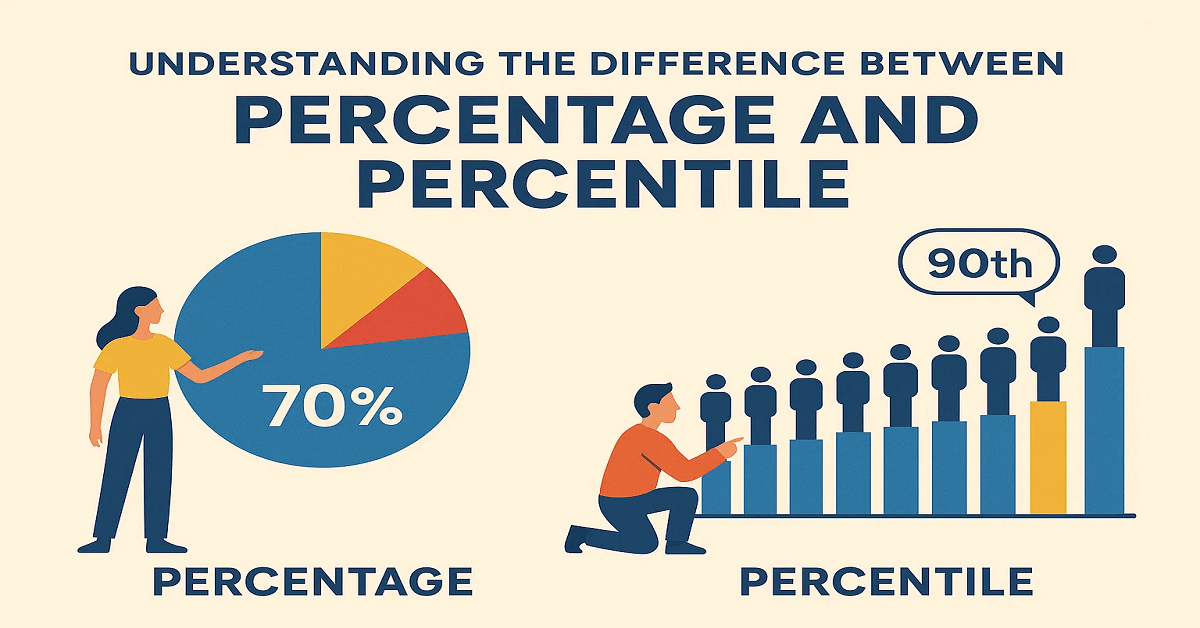In the competitive exam academics and its overall landscape, there are terms, such as percentage and percentile, that are often confusing and used interchangeably. However, they are not the same; knowing the difference between percentage and percentile is very important for students, parents, and educators to calculate performance correctly and make informed academic decisions.
However, both terms are associated with scoring and performance metrics, but they have entirely different purposes. So, let’s now understand the definitions, usage, and significance of percentile vs. percentage and explain what percentile score is in an easy-to-understand manner.
What is a Percentage?
A percentage is a value you get as a fraction of 100. In simple terms, it shows you how much you have scored out of the total possible marks.
If a student scores 90 marks out of 100, the percentage is calculated like this: (90/100)×100=90%(90/100).
This denotes that the student has achieved 90% of the total marks out of 100. So, the percentage is an absolute value— it simply shows your own performance, irrespective of how others performed in the exam.
Percentages are commonly used in:
- School and college report cards
- Semester examinations
- Internal assessments
It is a simple way to calculate and an easy way to understand. Remember, they don’t show your performance compared to other competitors.
What is the Percentile Score?
Now, let’s know what a percentile score is and how it is different from percentage. A percentile score is a relative performance indicator. It tells you the percentage of students who scored less than or equal to you in a particular exam or test.
Example:
If your score puts you in the 85th percentile, you have performed better than the rest, 85% of the students who appeared for the exam.
This doesn’t mean you scored 85%. You might have just scored 60%, but you’d still be in the high percentile.
Percentiles are used majorly in:
- Competitive exams like JEE, NEET, CAT, GRE, and SAT
- Large-scale assessments where performance is required to be ranked
- Evaluations where exam difficulty changes each year.
Even if your marks seem average, your percentile score could be excellent if the test is challenging and most students score low.
Key Differences Between Percentage and Percentile
To truly understand the difference between percentage and percentile, it helps to look at how different the work is in academic scenarios.
As said earlier, percentage is an absolute value. It shows how many marks you obtained out of the total percentage. For example, if you score 80 out of 100, your percentage is 80%; here, it does not consider how others have performed. It simply means the individual’s performance is based on the total marks.
Now, a percentile is a relative measure. It is used to understand analyze your rank or position compared to your competitors in some competitive or similar exams. Example: if you are in the 90th percentile, it simply means your score is better than 90% of all the students who have appeared for the test.
Importance of knowing the difference
When you want to interpret the academic and competitive exam results, understanding the difference between percentage and percentile will help you overcome a confusion, giving you clarity about the results.
Why it is important:
- An individual scoring 50% in a difficult will have 90th percentile, showing higher performance.
- Another student who might score 95% in an easy exam will have 80th percentile because many scored equally or higher.
That’s why percentile vs percentage plays a significant role in university admissions, scholarship decisions, and competitive exams.
When Should You Use Each?
Use percentage (%) when:
- If you are willing to evaluate your actual performance.
- In case when the exam has a fixed marking system as well as systematic grading patterns.
Use percentile when:
- If you wish to know your position or rank among a large number of aspirants.
- You’re taking a very competitive or standardized exam with proportional scoring.
Conclusion
To conclude, the difference between percentage and percentile is mainly about what exactly they evaluate.
Both of these marking indicators are crucial in two different contexts. While percentage gives you an idea of how much you’ve learned, percentile shows how well you have ranked in the group of aspirants, your competitors.
Therefore, understanding what a percentile score is and how it varies from a percentage is going to help you gain clarity when you analyze your result.
Do you want to boost your percentage and your percentile score? Enroll in 100plus Academy today! Our expert mentors and personalized guidance will help you do targeted preparation to excel in your school and competitive exams.
Sign up now to start your journey toward academic excellence and top rankings!


